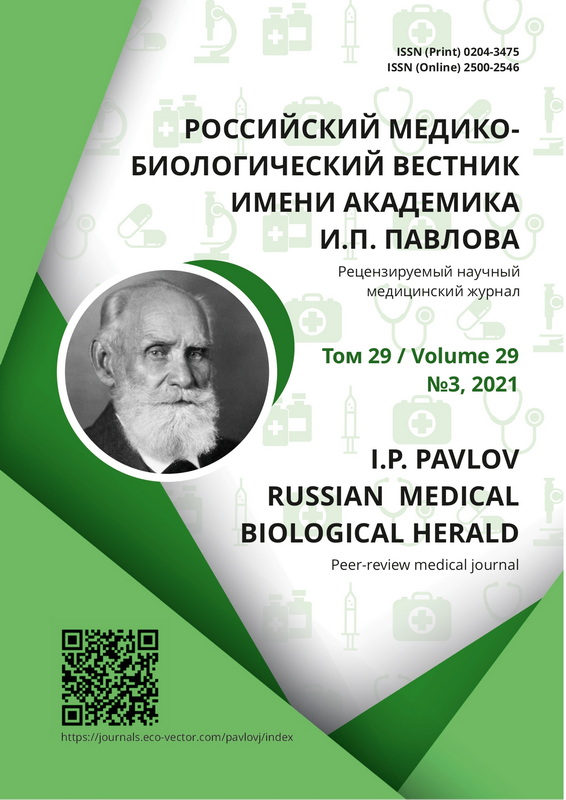静脉血管扩张术中应用巩膜置换术的经验(12个月观察结果)
- 作者: Sapelkin S.V.1, Druzhinina N.A.1, Kharazov A.F.1, Chupin A.V.1
-
隶属关系:
- Vishnevsky National Medical State Center of Surgery
- 期: 卷 29, 编号 3 (2021)
- 页面: 410-418
- 栏目: Original study
- URL: https://journal-vniispk.ru/pavlovj/article/view/62354
- DOI: https://doi.org/10.17816/PAVLOVJ62354
- ID: 62354
如何引用文章
详细
论证。静脉血管造影的切除干预涉及大面积失血的风险,并不总是能够保证血管瘤组织的完全切除和良好的美容效果结果。 在世界实践中,与开放式手术相比,巩膜置换术是一种微创技术,这包括在静脉空泡腔中引入硬化剂,从而导致闭塞。
目的:评价静脉畸形患者微创巩膜置换术的应用效果。
材料与方法。2006-2020年间采用硬化法治疗各种部位的静脉海绵状血管瘤41例,其中19例患者接受综合治疗,包括该技术与其他手术干预(血管瘤组织切除、激光和射频消隐)。
结果。38 名患者获得了临床改善。 根据超声控制数据,25例患者闭塞区无血流,干预后随访1年内初始症状消退。 随着血管瘤过程的局部扩散,治疗结果变得更好(对于弥漫性形式,不可能在 3 名患者中取得积极效果)。
结论。硬化症可以作为一种独立的方法在治疗静脉海绵状血管发育不良患者中提供积极的结果,并结合其他微创技术和血管瘤组织切除术。
作者简介
Sergey Sapelkin
Vishnevsky National Medical State Center of Surgery
Email: ssapelkin@yandex.ru
ORCID iD: 0000-0003-3610-8382
SPIN 代码: 3040-0699
д.м.н, ведущий научный сотрудник отделения сосудистой хирургии ФГБУ «Национальный медицинский исследовательский центр хирургии имени А.В.Вишневского»
俄罗斯联邦, MoscowNatal'ya Druzhinina
Vishnevsky National Medical State Center of Surgery
Email: dna13@mail.ru
ORCID iD: 0000-0002-6994-7310
SPIN 代码: 9124-0358
Researcher ID: ABG-9603-2020
Junior Researcher
俄罗斯联邦, MoscowAlexander Kharazov
Vishnevsky National Medical State Center of Surgery
Email: harazik@mail.ru
ORCID iD: 0000-0002-6252-2459
SPIN 代码: 5239-8127
Researcher ID: Q-8901-2018
MD, PhD, Associate Professor of the Department of Vascular and X-Ray Endovascular Surgery; Senior Researcher of the Vascular Surgery Departmen
俄罗斯联邦, 2/1, Barrikadnaya st., Moscow, 125993;Andrey Chupin
Vishnevsky National Medical State Center of Surgery
编辑信件的主要联系方式.
Email: dna13@mail.ru
ORCID iD: 0000-0002-5216-9970
SPIN 代码: 7237-4582
д.м.н., заведующий отделением сосудистой хирургии
俄罗斯联邦, Moscow参考
- Sapelkin SV, Druzhinina NA, Chupin AV, et al. Radiofrequency obliteration in treatment of venous angiodysplasia. I. P. Pavlov Russian Medical Biological Herald. 2021;29(1):89–98. (In Russ). doi: 10.23888/PAVLOVJ202129189-98
- Mulliken JB, Glowacki J. Hemangiomas and vascular malformations in infants and children: a classification based on endothelial characteristics. Plastic and Reconstructive Surgery. 1982;69(3):412–22. doi: 10.1097/00006534-198203000-00002
- Finn MC, Glowacki J, Mulliken JB. Congenital vascular lesions: clinical application of a new classification. Journal of Pediatric Surgery. 1983;18(6):894–900. doi: 10.1016/s0022-3468(83)80043-8
- Lee BB, Kim DI, Kim HH, et al. New experiences with absolute ethanol sclerotherapy in the management of a complex form of congenital venous malformation. Journal of Vascular Surgery. 2001;33(4):764–72. doi: 10.1067/mva.2001.112209
- Fishman SJ, Mulliken JB. Vascular anomalies. A primer for pediatricians. Pediatric Clinics of North America. 1998;45(6):1455–77. doi: 10.1016/s0031-3955(05)70099-7
- Park HS, Do YS, Park KB, et al. Clinical outcome and predictors of treatment response in foam sodium tetradecyl sulfate sclerotherapy of venous malformations. European Radiology. 2016;26(5):1301–10. doi: 10.1007/s00330-015-3931-9
- Ahmad S. Efficacy of Percutaneous Sclerotherapy in Low Flow Venous Malformations — a Single Center Series. Neurointervention. 2019;14(1): 53–60. doi: 10.5469/neuroint.2019.00024
- Kumar S, Bhavana K, Sinha AK, et al. Image-Guided Percutaneous Injection Sclerotherapy of Venous Malformations. SN Comprehensive Clinical Medicine. 2020;2:1462–90. doi: 10.1007/s42399-020-00412-y
- Chen RJ, Vrazas JI, Penington AJ. Surgical Management of Intramuscular Venous Malformations. Journal of Pediatric Orthopaedics. 2021;41(1):e67–e73. doi: 10.1097/BPO.0000000000001667
- Zhang J, Li H-B, Zhou SY, et al. Comparison between absolute ethanol and bleomycin for the treatment of venous malformation in children. Experimental and Therapeutic Medicine. 2013;6(2):305–9. doi: 10.3892/etm.2013.1144
- Su L, Fan X, Zheng L, et al. Absolute ethanol sclerotherapy for venous malformations in the face and neck. Journal of Oral and Maxillofacial Surgery. 2010;68(7):1622–7. doi: 10.1016/j.joms.2009.07.094
- Spence J, Krings T, TerBrugge KG, et al. Percutaneous treatment of facial venous malformations: a matched comparison of alcohol and bleomycin sclerotherapy. Head & Neck. 2011;33(1):125–30. doi: 10.1002/hed.21410
- Parsi K, Exner T, Connor D, et al. Letter: A Convenient Source of Carbon Dioxide for Sclerosant Foams. Dermatologic Surgery. 2006;32(12):1533–4. doi: 10.1111/j.1524-4725.2006.32370.x
- Cavezzi A, Flullini A, Ricci S, et al. Treatment of varicose veins by foam sclerotherapy: two clinical series. Phlebology. 2002;17(1):13–8. doi: 10.1007/BF02667958
- Parsi K, Exner T, Connor D, et al. The lytic effects of detergent sclerosants on erythrocytes, platelets, endothelial cells and microparticles are attenuated by albumin and other plasma components in vitro. European Journal of Vascular and Endovascular Surgery. 2008;36(2):216–23. doi: 10.1016/j.ejvs.2008.03.001
- Watkins MR. Deactivation of sodium tetradecyl sulphate injection by blood proteins. European Journal of Vascular and Endovascular Surgery. 2011;41(4):521–5. doi: 10.1016/j.ejvs.2010.12.012
- Tessari L, Izzo M, Kavezzi A, et al. Timing and modality of the sclerosing agents binding to the human proteins: laboratory analysis and clinical evidences. Veins and Lymphatics. 2014;3(1):3275. doi: 10.4081/vl.2014.3275
- Connor D, Cooley-Andrade O, Goh WX, et al. Detergent sclerosants are deactivated and consumed by circulating blood cells. European Journal of Vascular and Endovascular Surgery. 2015;49(4):426–31. doi: 10.1016/j.ejvs.2014.12.029
- Lee BB, Gloviczki P, Blei F, editors. Vascular Malformations: Advances and Controversies in Contemporary Management. CRC Press; 2020. P. 166.
- Star P, Connor D, Parsi K. Novel developments in foam sclerotherapy: Focus on Varithena®(polidocanol endovenous microfoam) in the management of varicose veins. Phlebology. 2018;33(3):150–62. doi: 10.1177/0268355516687864
补充文件










